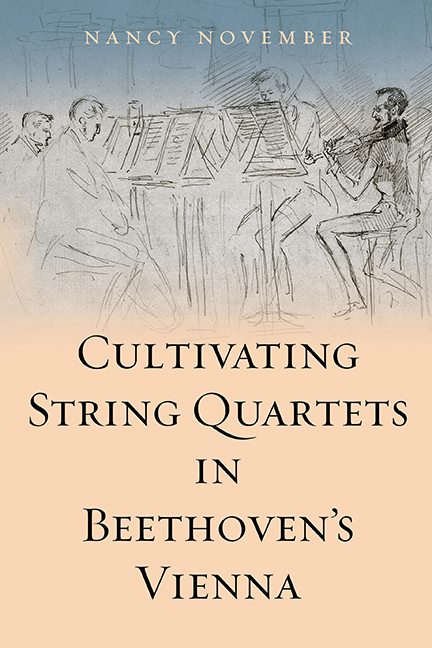Book contents
- Frontmatter
- Contents
- List of Illustrations
- List of Musical Examples
- Acknowledgements
- Introduction
- 1 Defining Chamber Music in the Early Nineteenth Century
- 2 Celebrating Haydn, Cultivating Opera
- 3 Selling String Quartets in Beethoven's Vienna
- 4 Locating String Quartets in Beethoven's Vienna
- 5 Early Nineteenth-Century Performance and Criticism
- 6 Sociability, Showmanship, and Study: ‘Quartet Friends’
- 7 The String Quartet and the Listener
- 8 Schubert's Song, Beethoven's Theatricality
- Epilogue: Constructing ‘Viennese Chamber Music’
- Bibliography
- Index
4 - Locating String Quartets in Beethoven's Vienna
Published online by Cambridge University Press: 16 May 2018
- Frontmatter
- Contents
- List of Illustrations
- List of Musical Examples
- Acknowledgements
- Introduction
- 1 Defining Chamber Music in the Early Nineteenth Century
- 2 Celebrating Haydn, Cultivating Opera
- 3 Selling String Quartets in Beethoven's Vienna
- 4 Locating String Quartets in Beethoven's Vienna
- 5 Early Nineteenth-Century Performance and Criticism
- 6 Sociability, Showmanship, and Study: ‘Quartet Friends’
- 7 The String Quartet and the Listener
- 8 Schubert's Song, Beethoven's Theatricality
- Epilogue: Constructing ‘Viennese Chamber Music’
- Bibliography
- Index
Summary
If one can liken the products of the large orchestra to theatre and panorama painting … if the solo player, on the other hand, is the miniaturist of music … then the quartet is the cabinet painting [Cabinetstück] of music, in that it unites both riches of composition and the greatest delicacy of performance.
The string quartet was increasingly set apart – literally and figuratively – as a special genre. Writing in 1810, Petiscus took care to locate it, aesthetically speaking, between orchestral and solo music. His choice of metaphor also relates to the genre's physical location at that time. Using the metaphor of the Cabinetstück he described the string quartet as an exemplary artwork. Cabinet paintings were objets d'art of a small scale, typically with intricate detail that could be appreciated only on close inspection. They were originally viewed by invitation only, in the chambers of princes or noblemen; they belonged in a choice, secluded collection, the Kunstkammer, removed from the public's gaze.
Writers from Hanslick onwards have observed that the string quartet was becoming less at home in courtly chambers, and was to be found more and more in public settings. Petiscus was writing from Leipzig, where, as in Vienna, the string quartet had already partly moved out of the Kunstkammer. Leipzig was home to the Gewandhaus-Quartett, a professional ensemble formed in 1808 after the model of Schuppanzigh's quartet in Vienna, who gave semi-public concerts from 1804 onwards. But the string quartet's move from ‘private’ to ‘public’ was a gradual process, which has been somewhat exaggerated in histories of the genre. If the courtly chamber was no longer its true home by 1810, the bourgeois drawing room and salon, rather than a public hall, were its most typical venues, in Vienna, Leipzig, and elsewhere.
The genre's departure from its courtly origins is complex. This complexity is especially apparent when one takes into account the various people who were involved in writing, selecting, programming, and performing these works in early nineteenth-century Vienna. Where, exactly were quartets performed, and by whom? How well were they played, and what other repertoire was available? Who preferred the easier, more modern works? Who started to construct a canon of chamber music ‘classics’? And how did all these circumstances begin to change during the era?
Information
- Type
- Chapter
- Information
- Cultivating String Quartets in Beethoven's Vienna , pp. 91 - 120Publisher: Boydell & BrewerPrint publication year: 2017
